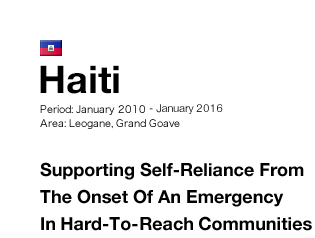
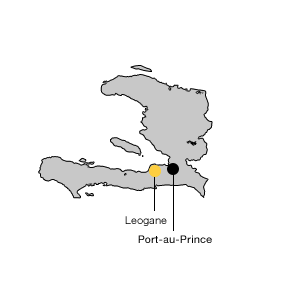
On January 12, 2010 at 21:53 GMT, a massive magnitude 7.0 earthquake struck Haiti. The epicenter was about 15 km southwest of the capital, Port-au-Prince, according to the U.S. Geological Survey. The quake caused major damage to Haiti, with the estimated death toll exceeding 300,000, comparable to the Sumatra earthquake in December 2004. JEN distributed emergency relief goods in the district of Grand Goave. While the district was devastated by the quake due to it being close to the epicenter, assistance had not yet reached because it was far from the capital. JEN subsequently provided this area with support to improve water and sanitation conditions in order to prevent the spread of waterborne infectious diseases such as cholera. In times of disaster, the people’s efforts to lead healthy lives are directly linked to the improvement of daily sanitation standards and the revitalization of the community. JEN has helped Haitians create self-reliant lives in the wake of devastation through activities to improve sanitation standards.
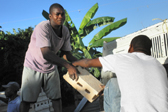
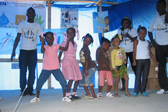
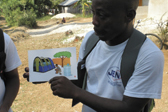
Helping the locals secure safe water by themselves through the installation of public water supply facilities (2013–2015)
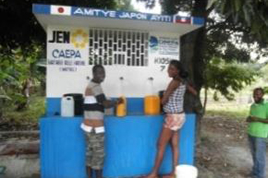
In Haiti, damaged water supply facilities are often left unrepaired. To improve this situation, JEN was committed to constructing a system that the local residents would be able to maintain on a long-term basis to secure access to safe water at any time.
In the six communities that JEN assisted, sixteen kiosk-type water supply facilities were built and one was repaired. In addition, we installed four water storage tanks and repaired two. Two communities among the six had a faucet-type water supply facilities with a structure too complicated for the residents to maintain by themselves, so JEN replaced nine of these units, including ones that were out of order, with ten kiosk-type systems that were maintainable by the residents.
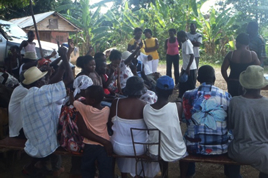
The kiosk-type is a box-shaped structure with three or four external faucets. An administrator in the kiosk controls the supply of water. Residents draw water from the external faucet and are charged for each bucketful of water.
A Water Management Committee was also formed to help residents maintain the water supply facilities in a sustainable manner. Elections were held to designate the Water Management Committee members who were then introduced to the residents in a General Meeting. The committee members formulated various rules including some for collecting water charges. In order to make it possible for the local residents to maintain these facilities over a long period of time, charges for using water were collected.
Aiming for the practice of hygiene habits, not just acquiring knowledge through training sessions for the prevention of infectious diseases (2013–2015)
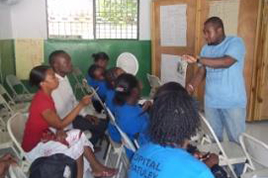
JEN has realized that the local residents who had acquired proper knowledge of hygiene would in many cases not put these methods into practice. In order to turn the knowledge into practice, we continually conveyed its significance to the local people. Hygiene promotion volunteers were recruited from the districts who would attend training sessions that were tailored to each individual’s level of knowledge. As a result, their awareness about hygiene was enhanced.
As for the other residents, hygiene knowledge and habits were improved through house-to-house visits and campaign activities organized mainly by the hygiene promotion volunteers who had received training. The hygiene promotion activities were conducted in accordance with the results of a preliminary survey, focusing on the residents’ hand-washing practice and prevention of waterborne diseases.
Creating an environment that allows access to safe water through the repair and installation of wells (2010-2013)
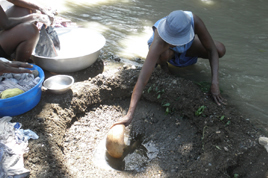
The reconstruction of Haiti requires improvements in various areas including sanitation standards, as the level of people’s awareness is generally low. Because the people affected by the earthquake have been receiving assistance for years they have developed a sense of dependency and thus their motivation to solve problems on their own has lowered. Following emergency assistance activities, JEN worked to improve this situation by repairing eighty water supply facilities that had been out of order in the rural areas of Leogane and Grand Goave where access to safe drinking water had been limited. Before the wells were constructed, community residents had been doing laundry at the same locations where they fetched drinking water. Some people even thought that they could get clean water by digging holes near the river, pouring wastewater into the holes, and waiting for the water to spring out of the ground again. The laundry areas were unsanitary with dirty puddles and breeding mosquitoes.
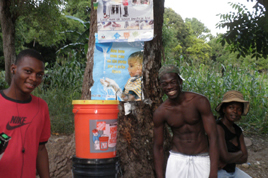
To change this situation, JEN set up the Well Management Committee. This group was comprised of five members of each of the 105 villages in Grand Goave and Leogane. They started off by cleaning the water supply facilities and their surroundings daily. At the same time, four to ten residents from each village participated in the same workshops as hygiene promoters in order to gain correct hygiene knowledge. The hygiene promoters, 459 people in total, installed a hand-washing area at the center of their villages, spread the practice of hand-washing with soap, carried out house-to-house visits to disseminate ways to prevent cholera infection, gave out quizzes about correct hygiene practices, and conducted hygiene campaigns.
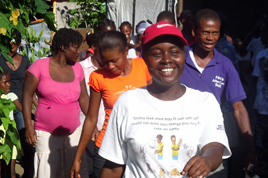
To further maintain the effectiveness of this assistance, Water Management Committees were established in ten new villages. Their tasks will include management and administration in addition to the keeping the wells clean. They will create a system to collect charges from the residents for using the wells which will save money for purchasing new replacement parts when wells break. Residents had been using natural river water until the wells were built. In other words, they were free to use any amount of water. In order to convince them to pay for water that has hitherto been free, it is vital that the residents understand what the Water Management Committee’s functions are and the importance of being able to use the wells.
Distribution of emergency relief goods (Feb.–May 2010)
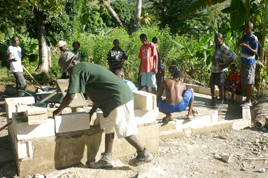
In addition to the Grand Goave district, JEN distributed emergency shelter kits to 4,000 households in the adjacent Leogane district because it was deemed necessary to provide further assistance. By adding much-needed timber to the items distributed initially (corrugated iron sheets, hammers, nails, saws, and work gloves), the affected people were able to improve their own living spaces by themselves.
Distribution of emergency relief goods (Jan.–Feb. 2010)
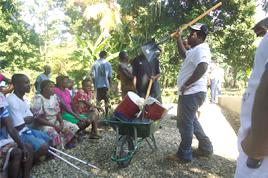
On January 16, 2010, immediately after the earthquake had occurred, JEN dispatched three international staff members who were emergency assistance experts and fluent in French. This was followed by one more member on January 27 to commence initial investigation along with emergency assistance.
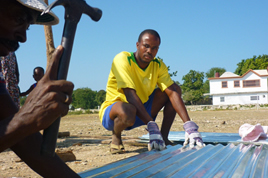
JEN distributed emergency shelter kits (corrugated iron sheets, hammers, nails, saws, and work gloves) to 700 households in seven camps in the Grand Goave district located some 50 km west of the Haitian capital of Port-au-Prince. The area was devastated by the quake due to the fact that it was close to the epicenter, but since it was far from the capital, assistance had not reached.
Basic Information
| Country Name | Republic of Hait |
| Capital | Port-au-Prince |
| Population | 10.71 million (as of 2015, the World Bank) |
| Area | 27,750km2 |
| Ethnic Groups | African origin (90%) and multiethnic |
| Languages | French and Creole (both official languages) |
| Religions | Christianity (Catholicism and Protestantism, etc.), Voodoo, and others |

